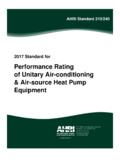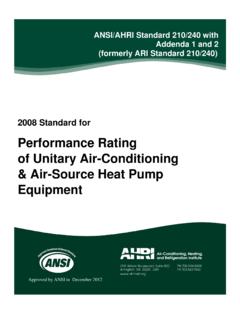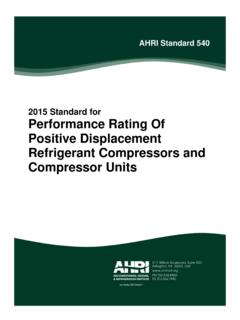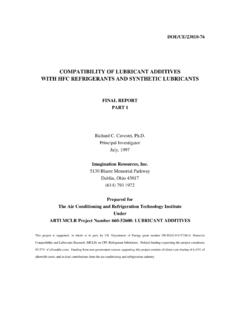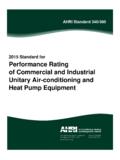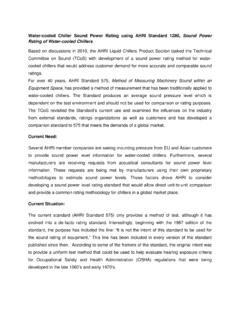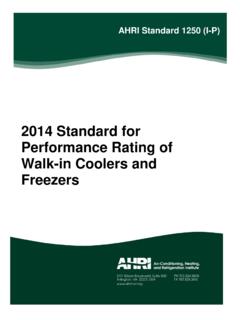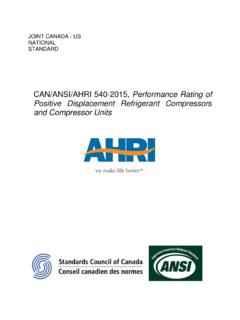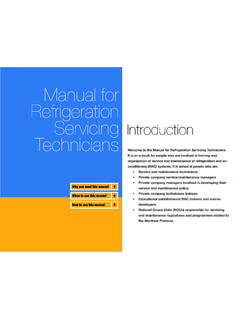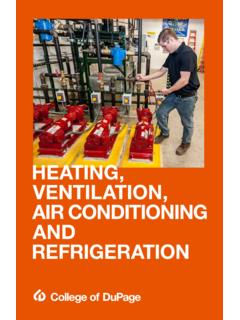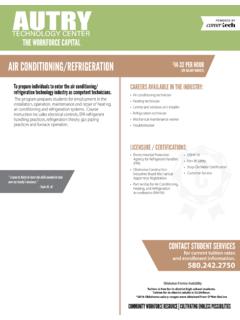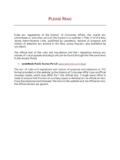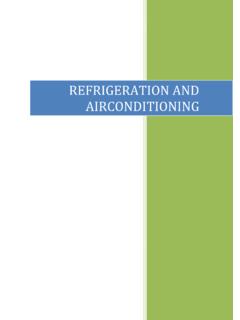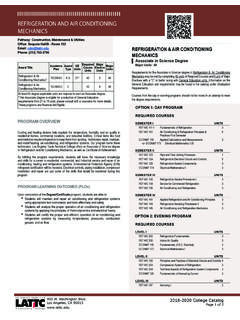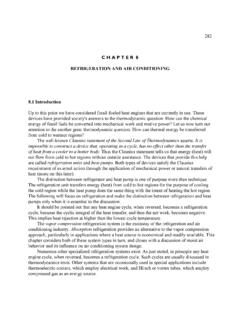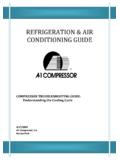Transcription of AIR-CONDITIONING, HEATING AND …
1 AHRTI Report No. 09002-01 PERFORMANCE STANDARDS FOR WALK-IN REFRIGERATOR AND FREEZER SYSTEMS Final Report January 2012 Bryan R. Becker, , , Brian A. Fricke, , Bryan C. Sartin BECO BECKER ENGINEERING COMPANY 22705 NW Ashford Court, Blue Springs, MO 64050-7333 Prepared for AIR- conditioning , HEATING and refrigeration TECHNOLOGY INSTITUTE, INC 2111 Wilson Boulevard, Suite 500, Arlington, Virginia 22201-3001 DISCLAIMER This report was prepared as an account of work sponsored by the Air- conditioning , HEATING and refrigeration Technology Institute, Inc. (AHRTI). Neither AHRTI, its research program financial supporters, or any agency thereof, nor any of their employees, contractors, subcontractors or employees thereof - makes any warranty, expressed or implied; assumes any legal liability or responsibility for the accuracy, completeness, any third party s use of, or the results of such use of any information, apparatus, product, or process disclosed in this report; or represents that its use would not infringe privately owned rights.
2 Reference herein to any specific commercial product, process, or service by trade name, trademark, manufacturer, or otherwise, does not necessarily constitute nor imply its endorsement, recommendation, or favoring by AHRTI, its sponsors, or any agency thereof or their contractors or subcontractors. The views and opinions of authors expressed herein do not necessarily state or reflect those of AHRTI, its program sponsors, or any agency thereof. Funding for this project was provided by (listed alphabetically): - Air- conditioning , HEATING and refrigeration Institute (AHRI) - Copper Development Association (CDA) - HEATING , refrigeration and Air conditioning Institute of Canada (HRAI) - New York State Energy Research and Development Authority (NYSERDA) TABLE OF CONTENTS EXECUTIVE SUMMARY.
3 I Research Objectives and Approach .. i Summary Of Findings .. i Recommendations .. ii INTRODUCTION .. 1 Research Objectives and Approach .. 1 Motivation .. 1 LITERATURE REVIEW .. 3 ANALYSIS OF MODEL LOAD PROFILES .. 8 Discussion of Pertinent Publications .. 8 Discussion of Model refrigeration Load Profiles for Walk-In Coolers and Freezers .. 12 Walk-In Coolers .. 12 Walk-In Freezers .. 17 Summary .. 22 ANALYSIS OF MONITORED DATA FROM FIELD SITES .. 33 Walk-In Cooler/Freezer Operating Data From National Resource Management, Inc.. 33 Description of the Remote Site Manager (RSM) System .. 33 Description of Field Sites from National Resource Management .. 37 Tedeschi Food Shop .. 37 Chili s 40 Analysis of Commercial Field Site Data from National Resource Management.
4 41 Summary .. 47 REVIEW AND SELECTION OF MODELING TOOLS .. 49 refrigeration System Modeling Tools .. 49 Whole Building Energy Simulation Programs .. 50 VALIDATION OF eQuest MODEL .. 52 Instrumented Walk-In Freezer at PG&E Food Service Technology Center .. 52 Description of FSTC Walk-In Freezer .. 52 Analysis of FSTC Walk-In Freezer Data .. 53 eQuest Modeling of the FSTC Walk-In Freezer .. 56 Simulation of the Actual PG&E FSTC Test Procedure .. 56 Results .. 59 Comparison of eQuest to Various Load Calculation Methods .. 60 Prototypical Walk-In Cooler .. 60 Load Calculation Methods .. 61 Results .. 62 eQUEST SIMULATIONS OF WALK-IN COOLER AND FREEZER PERFORMANCE .. 63 Small Single Speed Walk-In Freezer.
5 66 Small Freezer: Walk-In Box Description .. 66 Small Freezer: refrigeration Load Components .. 67 Small Freezer: Equipment Specifications .. 68 Small Freezer: Simulation Results .. 69 Small Single Speed Walk-In Cooler .. 75 Small Cooler: Walk-In Box Description .. 75 Small Cooler: refrigeration Load Components .. 76 Small Cooler: Equipment Specifications .. 77 Small Cooler: Simulation Results .. 78 Large Single Speed Walk-In Freezer .. 84 Large Freezer: Walk-In Box Description .. 84 Large Freezer: refrigeration Load Components .. 85 Large Freezer: Equipment Specifications .. 86 Large Freezer: Simulation Results .. 87 Large Single Speed Walk-In Cooler .. 93 Large Cooler: Walk-In Box Description.
6 93 Large Cooler: refrigeration Load Components .. 94 Large Cooler: Equipment Specifications .. 95 Large Cooler: Simulation Results .. 96 ANALYSIS OF SIMULATION RESULTS .. 102 Walk-in Box and Condensing Unit Inside .. 104 Walk-in Box Inside and Condensing Unit Outside .. 106 Walk-in Box and Condensing Unit Outside .. 107 AHRI 1250/1251 AWEF versus Average Climate Zone AWEF .. 111 Summary .. 114 117 RECOMMENDATIONS .. 121 REFERENCES .. 122 BIBLIOGRAPHY .. 125 Appendix A: Walk-In Cooler and Freezer Performance Data from National Resource Management, Inc.. 141 Appendix B: PG&E FSTC Walk-In Freezer Specifications, Test Procedure and Sample Data 173 Appendix C: Analysis of Measured Data from the FSTC Instrumented Walk-In Freezer.
7 174 Appendix D: Specifications of Prototypical Walk-In Cooler .. 198 Appendix E: Results from Various Load Calculation Methods for the Prototypical Walk-In Cooler .. 200 Appendix F: Derivation of AHRI 1250 Method-Of-Test Compressor Run Time .. 205 i EXECUTIVE SUMMARY Research Objectives and Approach The objective of this project was to substantiate and provide support for AHRI Standard 1250/1251, Standard for Performance Rating of Walk-In Coolers and Freezers (AHRI 2009b, 2009c). This objective was achieved by investigating walk-in cooler and freezer refrigeration load profiles and refrigeration system performance as a function of the ambient dry-bulb and wet-bulb temperatures surrounding the walk-in and its condensing unit.
8 This investigation included the following tasks: Literature Review Analysis of Model Load Profiles Analysis of Monitored Data from Field Sites Review and Selection of Modeling Tools Validation of eQuest Model eQuest Simulations Of Walk-In Cooler And Freezer Performance Analysis of Simulation Results Conclusions Summary Of Findings In summary, the most important findings of this project include the following: The AWEF generally increases with increasing compressor run time and with decreasing average ambient temperature. However, the behavior of a walk-in system is further complicated because a reduced average ambient temperature usually results in a reduced compressor run time.
9 So these two general trends tend to compete against each other and the combined effect on the AWEF of a walk-in refrigeration system depends upon the walk-in refrigeration system s operating characteristics. In general, the AHRI load profile agrees well with load profiles reported by other researchers. However, a few discrepancies exist in the AHRI load profile, including less door area for large walk-in coolers/freezers, absence of crack infiltration, and higher product loading for small walk-ins. The small AHRI cooler load correlates well with measured data from small in-service walk-in coolers, while there is less agreement between the large AHRI cooler and measured data for large in-service coolers.
10 The loads for the AHRI small and large freezers are considerably less than the measured data from in-service walk-in freezers. Comparison of simulated climate zone AWEF s versus simulated AHRI 1250/1251 method-of-test AWEF s for walk-in freezers shows very good agreement. However, significant differences exist between the simulated climate zone AWEF s and the simulated AHRI 1250/1251 method-of-test AWEF s for walk-in coolers. ii Recommendations Based upon the results of this project, the research team makes the following recommendations: 1. The research team recommends that an additional research project be initiated that would focus on monitoring walk-ins located in all seven climate zones that make up the continental United States.
